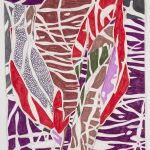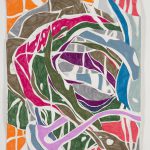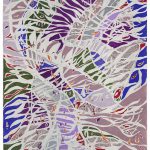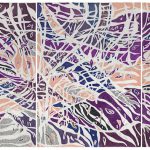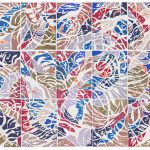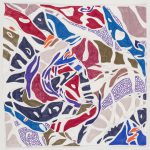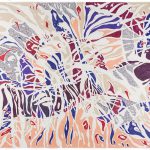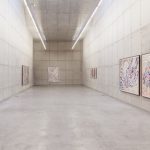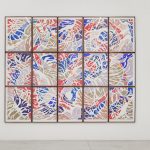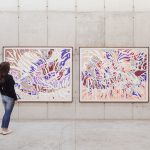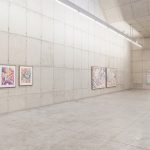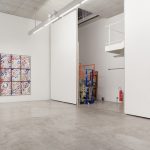Failed Acts
The set of works showcased in Failed Acts suggests an ongoing movement interrupted and renewed in each drawing. The works vibrate with an internal pulse, to the rhythm of an eternal mismatch between areas filled with colour and the emptiness of zones left white. As two immiscible liquids, this ambiguous game of repulsion or attraction between opposite poles insinuates a mating dance. The question remains whether the void is about to be filled or if the colour fields will dissolve in the vacuum. Despite pursuing with her formal research, the apparent flow characteristic of Marcia de Moraes’ latest compositions and the friction contained therein, point to a renewed impetus in which discontinuities are concealed.
This tension is already manifested in her process, in the direct confrontation with the paper, a battlefield in which the artist’s subjective landscape is opposed to the impetus that moves her hand. Drawing without a prior sketch, Marcia de Moraes uses the previous work as a parameter to draft a new composition in the manner of a cadavre exquis. In fact, after outlining the general structure and constituting lines with graphite, the artist determines the areas of the paper to be filled and the colours to be used. Letting herself be guided by chance and intuition, Moraes’ hand consents that surprises emerge on the surface of the drawing.
These surprises take the form of stylized motifs, which are derived from concrete elements such as swimming pools, teeth or hooks that punctuate the winding and often swirling compositions of Marcia de Moraes. These unusual details -that at some point caught the attention of the artist – resurface from the frantic pace of everyday life in which they were lost. If these figurations are deprived of all their narrative quality, they insinuate themselves with the latent violence of sharp and incisive silhouettes that penetrate the territory of flaccid abstraction that characterizes the artist’s work.
These intruding elements come about in prismatic compositions that, in this group of works more than in the previous ones, induce a rupture of the gaze. In fact, in previous works the viewer’s gaze could converge in the center of a circular agency of forms clearly framed by the four corners of the paper. Such a confinement of the gaze in this graphic territory, suggested that the spectator was confronted with a living unity, which embraced both light and shadow, full and void. In addition, the white areas appear as fillets, fragile strips in regard to the prevailing surfaces of vibrant colours. Currently, despite a compositional harmony in which the colour masses are balanced, it is more difficult to discern an underlying order to the drawing, which seems to be pierced by a vertical or horizontal stream, causing the eyes to be directed out of the limits of the paper. The voids gain in proportion, invading the entire surface of the drawings, in an intricate labyrinth of gaps. It is in the act of looking that the enlarged hiatus between form and background must be supplied.
It comes as no surprise that it is in this moment, when the idea of rupture becomes increasingly present in her work, that Marcia de Moraes begins to develop a series of collages. The artist uses parts of her drawings, remains of potential compositions, and arranges them in a new disposition that results in a complex angle of meshes and colours. Fragmentation is here materialized by an effective discontinuity that not only happens through the interruption of the lines, but also through the physical superposition of the different intricate planes, which appears as a kaleidoscope of mistakes.
In turn, this fragmentation also contaminates her production of drawings. For example, the fifteen constituting drawings of TerritórioTerritory) function like different pieces of a puzzle. On the one hand, a certain continuity is evident in the colour palette, the meshes used to fill some of the drawing fields as well as in the sensation that a unique gesture outlined the lines with graphite. However, it is a dysfunctional puzzle since the junction of the different parts does not coincide. These mismatches and the voids that they generate, once again frustrate the promise of an homogeneous ensemble, and the eye remains in the edges of drawings.
Increasingly, this dynamic of disruption and fissuring in Marcia de Moraes’ drawings and collages, seem to induce a displacement of the gaze. To a certain extent, these formal interruptions can allude to the psychoanalytic notion of “lapsus”, that inspired the name of this exhibition. As explained by Sigmund Freud in the early twentieth century, the lapsus would be errors in actions or speech, breaches in speech and in the logic of linear thinking caused by the unconscious. Both in her process – in which a work, as well as any possible failures, are the starting points for the next one – as in the condition of sketch suggested by the errors and graphite traces left apparent, or in the presence of some figurative elements from everyday life, the work of Marcia de Moraes seems to refer to such lapses of memory or speech for no apparent reason.
These compulsive behaviours and unconscious shortcuts, according to the analyst, had the intention to externalize a deep and hidden desire. From this perspective, perhaps Marcia de Moraes’ aspiration could be crystallized in an ongoing quest for a vertigo induced by the loss of references and the oscillation between repeated lapses and a continuity that escapes through the edges of the paper.
Olivia Ardui
April 2015


